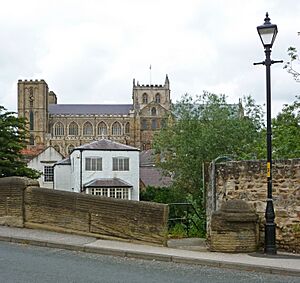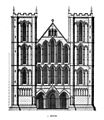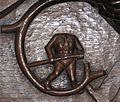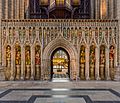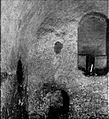Ripon Cathedral facts for kids
Quick facts for kids Ripon Cathedral |
|
|---|---|
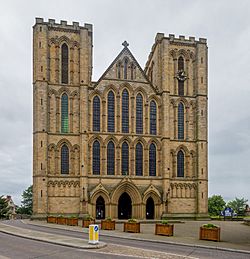
The west front of the cathedral
|
|
| Lua error in Module:Location_map at line 420: attempt to index field 'wikibase' (a nil value). | |
| OS grid reference | SE 31446 71129 |
| Location | Minster Road, Ripon, North Yorkshire HG4 1QT |
| Country | England |
| Denomination | Church of England |
| Previous denomination | Roman Catholic |
| Tradition | Liberal Anglo-Catholic |
| History | |
| Status | Cathedral (since 1836) |
| Architecture | |
| Functional status | Active |
| Heritage designation | Grade I |
| Style | Anglo-Saxon, Gothic (Early English) |
| Years built | 1160–1547 |
| Administration | |
| Diocese | Leeds (since 2014) |
| Province | York |
The Cathedral Church of St Peter and St Wilfrid, usually called Ripon Cathedral, is a famous church in Ripon, North Yorkshire, England. Before 1836, it was known as Ripon Minster.
This church has a long history. It started as a monastery in the 660s. Later, in 672, St Wilfrid rebuilt it as a Benedictine monastery. The church became very important in the Diocese of York during the Middle Ages.
The building you see today is actually the fourth church on this spot. It was built between the 13th and 16th centuries. In 1836, it officially became a cathedral. This means it's the main church for a bishop. Since 2014, it has been one of three cathedrals for the Anglican Bishop of Leeds.
Ripon Cathedral is known for its beautiful Gothic style. Its west front is a great example of the Early English Gothic style. The old crypt, built in the 7th century, is also very special. It shows how early Christian churches were built in England. The cathedral is a Grade I listed building, which means it's a very important historic place.
Contents
A Look at Ripon Cathedral's History
There has been a stone church here since 672. That's when Saint Wilfrid replaced an older wooden church. He wanted a church built in the Roman style. This was one of the first stone buildings in the ancient Kingdom of Northumbria. The oldest part of the cathedral, the crypt, is from this time.
Building the Great Basilica
Saint Wilfrid brought skilled workers from France and Italy. They helped him build a huge church, called a basilica, in 672 AD. A writer from that time, Stephen of Ripon, described it. He said it was built of dressed stone, with many columns, tall walls, and arched ceilings.
Saint Wilfrid was buried in this church. Sadly, the church was destroyed in 948 AD by the English king Eadred. Only Wilfrid's crypt survived. This small 7th-century chapel still rests beneath the larger church built later.
Churches Through the Ages
A second church was built at Ripon, but it was also destroyed. This happened in 1069, by William the Conqueror. Then, Thomas of Bayeux, the first Norman Archbishop of York, started building a third church. Some parts of this church are still in the current building.
The beautiful Early English west front was added around 1220. Its two towers once had wooden spires covered in lead. The large east window was built between 1286 and 1330. It's a "splendid" example of the Decorated Gothic style.
Big building projects were put on hold because of the Wars of the Roses. But work started again after Henry VII became king in 1485. The central tower was rebuilt after it fell down in an earthquake in 1450. However, it was never fully finished.
Between 1501 and 1522, the walls of the main part of the church (the nave) were made taller. New side sections (aisles) were also added. The church has thirty-four misericords, which are small wooden seats with carvings. These were carved between 1489 and 1494. During the Civil War, much of the stained glass and some statues were broken.
Becoming a Cathedral
The church officially became a cathedral in 1836. It was the main church for the new Anglican Diocese of Ripon. This was the first new diocese created since the Reformation.
Music at Ripon Cathedral
Ripon Cathedral is known for its music. It has a wonderful organ and a set of bells.
The Cathedral Organ
The cathedral has a great organ built by Harrison and Harrison. It was rebuilt from an older organ from 1878. The organ is on a screen and has beautiful wooden casing. It was last cleaned and repaired in 2013.
The Bells of Ripon
The south-west tower holds a ring of 12 bells. There's also an extra 'flat sixth' bell. A set of ten bells was made in 1932. In 2008, three more bells were added. This created a full set of twelve bells for change ringing.
Gallery
-
A misericord, said to have inspired Alice's Adventures in Wonderland
-
Stained glass window of St Michael, at the West end.
-
Moses and Melchizedek; Stained glass window, St Peter's chapel.
See also
 In Spanish: Catedral de Ripon para niños
In Spanish: Catedral de Ripon para niños
- Ripon
- Architecture of the medieval cathedrals of England
- English Gothic architecture
- Romanesque architecture
- Church of England
- Diocese of Leeds
- Dean and Chapter of Ripon
- List of Gothic Cathedrals in Europe


